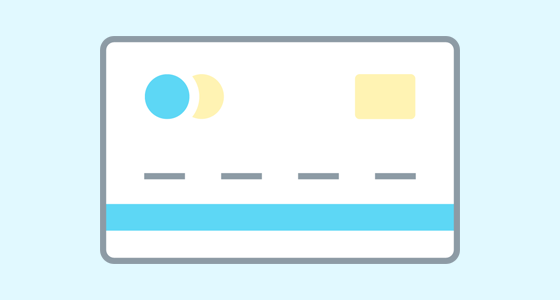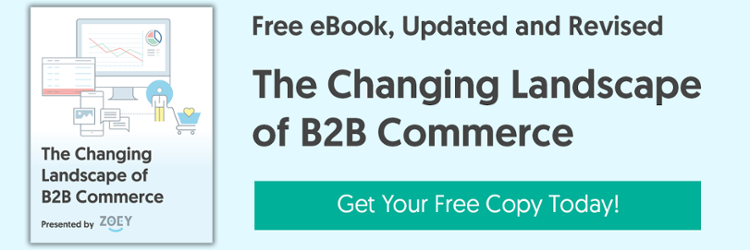The B2C Ecommerce space has long understood that sometimes you need to offer multiple payment options to manage various concerns and requirements of customers. In the B2B space, that is also the case, although the payment methods may look different.
4 Types of Payment Methods
Here are the common types of payment methods for B2B wholesale transactions, and steps merchants can take to ensure they’re making the most of Ecommerce payment methods.
1. Credit Cards
Credit cards have been a very common form of payment online since the beginning, since they offer the purchaser protection in certain ways from problems, and can many times effectively finance the purchase for a few weeks without interest. Merchants have also been appreciative of them as they ensure immediate payment.
For B2B merchants, the biggest challenge for these types of purchases is that credit card fees can be expensive. Because Ecommerce transactions are not physical, with a customer walking into a store and presenting a card to swipe or insert a chip, the risk is inherently higher, and the fees reflect that.
However, compared to its B2C counterpart, B2B purchases as a whole tend to carry less risk. Corporate credit cards are backed by a company with a different purchase history and financial situation vs. an individually liable card. The average order size is higher, and the risk of non-payment or a chargeback is lower.
As such, many credit card processors with a focus on B2B transactions offer support of Level 2 (supported by Visa, Mastercard and American Express) and Level 3 (supported by Visa and Mastercard) data, which can allow a merchant to qualify for lower processing rates, as much as a full percentage point lower than a B2C transaction.
If you are a B2B or wholesale merchant selling online, but have avoided credit cards because they eat too much margin, or opted not to sell online because of that problem, it’s worth evaluating whether the right payment provider can assist you in achieving that goal.
2. PayPal
Perhaps not surprisingly, PayPal’s strength as a consumer payment option has bled into the B2B space, with many small businesses accepting and sending PayPal payments because of the convenience factor of having your payment accounts tied together through a unified system. PayPal also allows payments to be sent without typing a credit card into an unknown site, and like credit cards has some protections for buyers that can be assuring.
PayPal similarly has options that can be beneficial for merchants, such as the ability to get money in their hands faster than methods like wire transfers. Because bank-funded payments are possible, combined with some of the other card benefits above, PayPal too can sometimes yield a lower effective rate than its B2C counterpart. However, PayPal can also be a conversion driver for businesses who are a bit more skittish about entering credit cards into unknown websites, particularly challenging when this is a first-time purchase from your store. So having an additional option might prove helpful to driving more conversions.
3. Net Terms
We’ve previously covered the benefits of Net Terms on the blog, but this common B2B-specific payment option is one that many online B2B merchants leverage: A buyer places and order and has a term window (usually Net 30, for 30 days, or Net 60, for 60 days) to pay the invoice.
Net Terms is definitely a valuable option for merchants to drive more sales as a counterpart to credit cards. It can be less expensive than credit cards if the merchant effectively finances the purchase, because there is no fee to be paid to the credit card company. However, in that scenario the merchant is on the hook if an invoice is not paid – depending on the default rate, that can get expensive, and in the worst scenarios can exceed the cost of credit cards.
Many merchants operating in this fashion aren’t able to do full background or credit checks on their customers, so the risk is heightened relative to a credit card or PayPal as there’s the chance they take on a customer who is not in a strong financial position.
As such, a number of financing companies are popping up to effectively finance the net terms to buyers on behalf of the merchant. In exchange for a fee, usually a percentage of the purchase, a merchant can get paid sooner and be guaranteed payment. The financing company takes on the risk and collects the payment from the buyer under the terms agreed to. And if the buyer fails to pay, it’s the financing company that has to deal with the issue.
As such, the financing company is likely to do a more thorough background or credit check, or through other companies they work with already have experience or exposure to some of your customers and know what to expect. Meanwhile B2B merchants can have the benefits of not being the financier of the transaction, and with payments coming quicker, can also benefit from improved cashflow over if they had to collect on invoices themselves.
4. Automated Clearing House (ACH)
Less common for Ecommerce, but growing, is the ability for online merchants to accept ACH payments. ACH payments can be processed directly from a checking or savings account, which also comes with a much lower cost vs. credit cards.
On the downside, ACH transactions embedded into Ecommerce are not as simple to achieve, and less providers have accessible and simple solutions. This is because since you’re now processing transactions connected directly to a banking account, there tends to be a higher bar to clear for merchants to accept and buyers to order.
Processing times are also a bit slower than credit card counterparts – expect ACH to take a couple days longer to hit your bank account over credit cards. But many merchants will accept a bit more of a lag in exchange for a huge cost savings on those transactions.
The other downside is, like writing a check, ACH payments can get reversed for non-sufficient funds (NSF). As such, many merchants that accept ACH have to set up similar penalties to merchants who accept checks for NSF scenarios. You also may want to only allow ACH payments to be available for certain customer groups with more reliable payment histories.
Different Types Payments for Different Groups
As you can see, payments are not a one-size-fits-all solution. And since different types of payment methods carry different pros and cons than others, some B2B Ecommerce merchants may find the need to offer a variety of options, but only activate certain payment options for certain groups.
Zoey’s Customer Groups feature allows merchants to decide which payment options are available for each group. If you want less risky payment options upfront for new customers or ones where issues have occurred in the past, you can do so, while creating other groups that get access to more trusted options when they have a stable history, striking a balance between cost and risk that maximizes your opportunity with your B2B Ecommerce business
Other Checkout Optimization Recommendations
Mobile conversion rates continue to lag behind their desktop counterparts, and if you’re a smaller merchant, you’ve got the natural concern many potential customers may feel about entering their credit card in an unknown site. There are therefore a number of steps merchants can take to improve their chances for conversion, making it a win-win for customers and merchants alike.
We hosted a webinar with PayPal that covered:
- PayPal’s data about optimizing checkout for mobile and web
- How, when and why to leverage alternative payment methods
- A checklist of quick changes you can implement today to increase conversions
Many of the suggestions can be implemented relatively quickly on Zoey, so merchants are well served to consider some of the tips offered in the below webinar:
Learn How Zoey Can Help Your Business
Zoey offers a variety of payment options and can connect to third party systems like QuickBooks Online for managing your payments and invoicing options. To learn how Zoey can help your business, click the button below to request a demo:
You can also download Zoey’s new eBook, “The Changing Landscape of B2B,” which comes with a plethora of other tips and advice for B2B Ecommerce business on how to improve their ability to draw and sell to customers in their space. Click the image below to request your copy:






